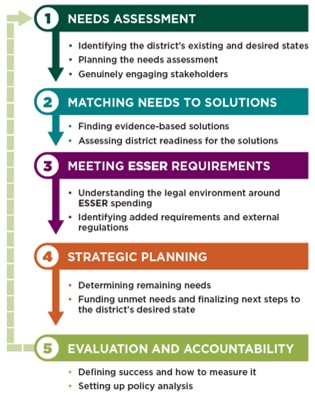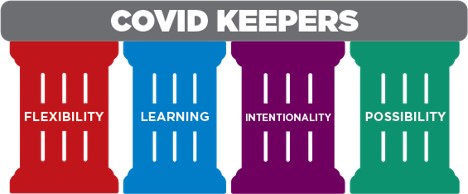Michigan State University is helping schools and communities through and beyond the COVID pandemic with two new resources based on insights from working closely with educators across the state.

The white papers, published by the College of Education’s Office of K-12 Outreach, include a guide to using federal relief dollars provided to school districts and perspective on how changes that emerged during the pandemic can improve education in the future.
ESSER answers
“A COVID-19 Relief Dollars Process Guide” focuses on the Elementary and Secondary School Emergency Relief (ESSER) Fund resources that federal lawmakers allocated to schools, districts and state education agencies to start the rebuilding process following the pandemic.

This tool reviews the importance of “once-in-a-lifetime” federal relief funding for K-12 education, summarizes key legislative details around ESSER funds, and presents a five-step decision-making model for how these dollars might be used. In doing so, it supports school and district planning around impactfully utilizing federal relief funds, such as to address potential learning losses. This resource also aids students, parents, educators, community members and policymakers curious about how they might influence local funding decisions.
FLIP the script
“COVID Keepers: FLIP the Script” reflects on how various “traditional and well-known structures that have defined K-12 education for decades” can be challenged by lessons learned during the COVID-19 pandemic. Specifically, it flags a collection of practices, mindsets, programs and ideas that emerged in the struggle of the [pandemic] but that “should persist as in-school, face-to-face schooling resumes.”
Systemically, this resource presents these items in a framework called FLIP, which includes prioritizing flexibility, unique learning opportunities, intentionality, and the need to consider the possibility of a better future. It stands out in identifying these themes directly from education practitioners who shepherded youth through the generation-shaping pandemic.
“What are some of the COVID keepers, experiences that were different but effective?” said Bryan Beverly, director of the Office of K-12 Outreach. “Although not being in school was a challenge for many students, some students really excelled during the pandemic in remote learning, and we were able to leverage parent and student engagement in different ways.”

Beverly and his team believe that if educators, support staff and administrators can remember what worked in the COVID-19 pandemic, they can “FLIP the learning paradigm to a post-pandemic environment that honors students as they navigate the educational environment.”
A series of additional papers is planned to build on the COVID Keepers report.
Written in part by Tyler Thur
Related stories
Two College of Education scholars shared insights on COVID-related recovery in schools during the Institute for Public Policy and Social Research’s Public Policy Forum on Nov. 17, 2021. This included information about federal recovery funding from Jacqueline Gardner, director of data and evaluation for the Office of K-12 Outreach, and information on learning impacts from Katharine Strunk of the Education Policy Innovation Collaborative (EPIC). Gardner and Strunk were also interviewed on WXYZ’s Spotlight on the News, along with IPPSR Director Matt Grossman.
How have schools responded to the impact of COVID? Here’s a timeline, with insights from EPIC and the Office of K-12 Outreach.
With leadership from the Office of K-12 Outreach Director Bryan Beverly, MSU is part of a statewide collaboration providing resources for teachers on the best practices in online teaching.
MSU Professor David Arsen shared “how Michigan should spend billions in school funding” in a Detroit Free Press opinion piece.